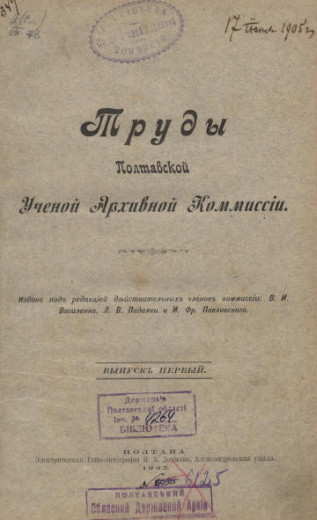Poltava Gubernia Learned Archival Commission
Poltava Gubernia Learned Archival Commission (Полтавська губерніяльна вчена архівна комісія; Poltavska huberniialna vchena arkhivna komisiia). An archival commission founded in Poltava in 1903 to research the archeology, history, ethnography, and culture of Poltava gubernia and to protect ancient monuments there. Funded by membership dues and the Poltava Gubernia Zemstvo, it soon broadened its scope to include Kharkiv gubernia and Kamianets-Podilskyi gubernia and became an important center of Ukrainian regional studies. Its members (eg, Ivan F. Pavlovsky, Lev Padalka, Volodymyr Parkhomenko, Viktor Vasylenko, Vadym Modzalevsky, Mykola O. Makarenko, Volodymyr Shchepotiev, Opanas Slastion, Vasyl Myloradovych, Vadym Shcherbakivsky, Mykhailo Rudynsky, Pavlo Klepatsky, Hryhorii Kovalenko, V. Buchnevych, I. Zaretsky, M. Astriab, I. Zubkovsky, P. Hniedych) produced many monographs and articles. The commission itself published their research and documentary and archival materials in its serial Trudy Poltavskoi uchenoi arkhivnoi komissii (15 vols, 1905–17). Separately it published Buchnevych’s book on Poltava and its monuments (1902); Pavlovsky’s book on 19th-century Poltava (1907), biographical dictionary of the scholars and writers of Poltava gubernia (1912; supplement 1913), and description of Poltava gubernia’s archives (1915); the records of the 17th-century Poltava municipal government (ed Modzalevsky, 3 vols, 1911–14); a systematic index to the journal Kievskaia starina (1911); Zubkovsky’s history of Myrhorod (1912); Padalka’s books on the history of Poltava eparchy (1914) and the Poltava region and its colonization (1914); materials on the folk oral literature of Romny county compiled by Hniedych (4 vols, 1915–16); and Makarenko’s book on the fortified settlements and kurhans in Poltava gubernia (1917). It operated its own library, initiated the creation of a museum of church antiquities in Poltava, and in 1909 opened the Museum of the Battle of Poltava (the director was Pavlovsky). In 1918 the commission was succeeded by the Ukrainian Scientific Society for the Research and Protection of Monuments of Antiquity and Art in the Poltava Region, which published one volume of Zapysky (1919). In 1922 it was renamed the Poltava Scientific Society of the All-Ukrainian Academy of Sciences, and under that name it published another volume of Zapysky (1928). In the early 1930s many of its 70 members were repressed, and the society was abolished.
Roman Senkus
[This article originally appeared in the Encyclopedia of Ukraine, vol. 3 (1993).]
